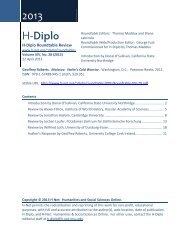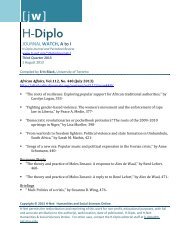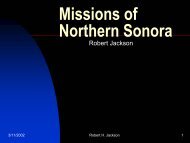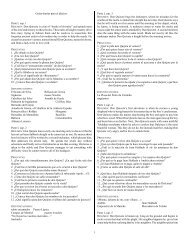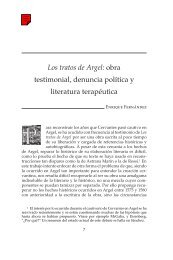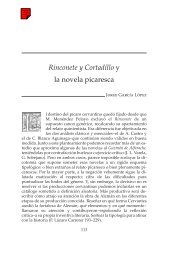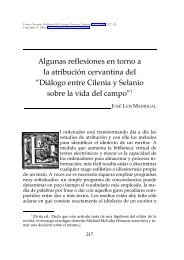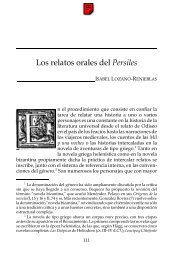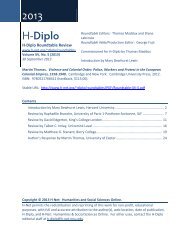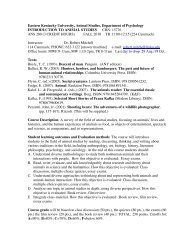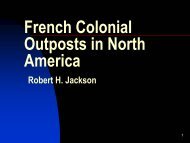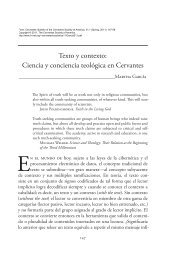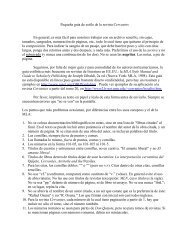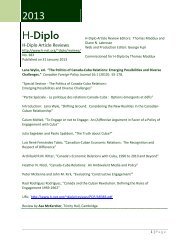H-Diplo Roundtables, Vol. XIV, No. 29 (2013) - H-Net
H-Diplo Roundtables, Vol. XIV, No. 29 (2013) - H-Net
H-Diplo Roundtables, Vol. XIV, No. 29 (2013) - H-Net
You also want an ePaper? Increase the reach of your titles
YUMPU automatically turns print PDFs into web optimized ePapers that Google loves.
H-<strong>Diplo</strong> Roundtable Reviews, <strong>Vol</strong>. <strong>XIV</strong>, <strong>No</strong>. <strong>29</strong> (<strong>2013</strong>)<br />
Pao’s closest American confidant, basically viewed the U.S.-Hmong relationship as a parentchild<br />
one. From his standpoint, the Hmong gained a leg up over other Laotian ethnic<br />
groups by being enthusiastic and aggressive children. It took no effort to motivate them,<br />
which came as a relief after dealing with the slugabeds in the Royal Lao Army (RLA). But<br />
there was still a vast gulf in maturity between “Pop” and his wards. 20<br />
Anderson’s review is so generous and complimentary that I’m tempted to limit my<br />
response to a heartfelt “thank you.” Still, he indirectly poses a question that several readers<br />
of Universe Unraveling have broached outright: Do I, in my zeal to revise the standard<br />
interpretation of Washington’s Laos policy, downplay the logistical difficulties involved in<br />
waging war on the other side of the planet in a craggy, disease-ridden kingdom lacking<br />
both infrastructure and coastline? In a word, no. Never in the book do I minimize these<br />
challenges; in fact, I devote several pages to identifying and detailing them. Make no<br />
mistake: Laos did present what Lawrence Freedman calls “a logistical nightmare” to U.S.<br />
policymakers. 21 Yet so did South Vietnam. Neither country’s terrain accommodated<br />
modern, mechanized forces. Both had climates that fostered malaria and dysentery. True,<br />
the means of naval access to South Vietnam were much more extensive, but Laos shared a<br />
thousand-mile border with the U.S. ally Thailand, whose leader, Sarit Thanarat, was<br />
General Phoumi’s cousin and more than willing to allow Washington to use his nation as a<br />
base from which to attack the Pathet Lao. Add to this the fact that, by 1960, most of the<br />
fighting between the RLA and the communists took place in the Plain of Jars, an open<br />
plateau where U.S. aircraft and heavy weapons could be used to their full advantage, and<br />
the old logistical thesis looks even more threadbare. “Logistics be damned!” snapped<br />
Senator Richard Russell during Kennedy’s pivotal encounter with congressional leaders on<br />
April 27, 1961. The important thing, as far as Russell and his fellow legislators were<br />
concerned, was that America fought “where we have an ally that will fight for himself,” and<br />
that was clearly not the case in Laos (237).<br />
Since I’ve never been one to tackle the most difficult part of an assignment immediately,<br />
I’ve saved Foster’s review for last. She makes a fair point. According to Universe<br />
Unraveling, Americans’ conception of the Lao was not only derogative; it was static. The<br />
smirking obloquy expressed by Embassy Chargé Robert McClintock in his 1954 position<br />
paper “A U.S. Policy for Post-Armistice Indochina,” perhaps the earliest in-depth analysis of<br />
Laos as a potential cold war battlefield, did not differ appreciably from reports Kennedy<br />
received from his Laos Task Force in 1962, after Washington had been trying to stem the<br />
communist tide in Laos for nearly a decade. American “stereotypes . . . failed to evolve over<br />
time into more sympathetic understanding, despite the . . . opportunities afforded<br />
Americans to delve into the motives and objectives of their Lao allies,” I observe, and<br />
20 My treatment of this asymmetrical alliance echoes Naoko Shibusawa’s pioneering work on postwar<br />
U.S.-Japanese relations, the first to deploy maturity as a category of analysis. See Naoko Shibusawa, America’s<br />
Geisha Ally: Reimagining the Japanese Enemy (Cambridge, MA: Harvard University Press, 2006).<br />
21 Lawrence Freedman, Kennedy’s Wars: Cuba, Berlin, Laos, and Vietnam (New York: Oxford<br />
University Press, 2000), <strong>29</strong>8.<br />
30 | P age



